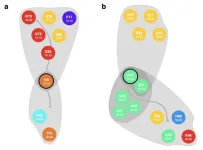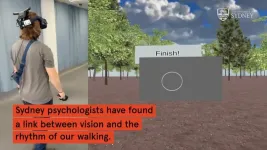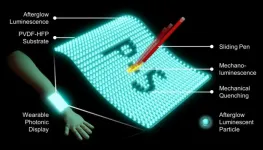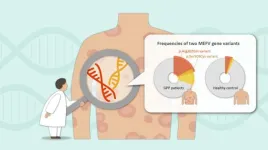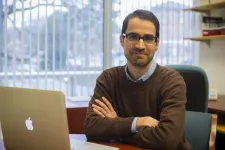(Press-News.org) [Vienna, March 5 2024] — The world population is aging at an increasing pace. According to the World Health Organization (WHO), in 2023, one in six people were over 60 years old. By 2050, the number of people over 60 is expected to double to 2.1 billion.
“As age increases, the risk of multiple, often chronic diseases occurring simultaneously—known as multimorbidity—significantly rises,” explains Elma Dervic from the Complexity Science Hub (CSH). Given the demographic shift we are facing, this poses several challenges. On one hand, multimorbidity diminishes the quality of life for those affected. On the other hand, this demographic shift creates a massive additional burden for healthcare and social systems.
Identifying typical disease trajectories
"We wanted to find out which typical disease trajectories occur in multimorbid patients from birth to death and which critical moments in their lives significantly shape the further course. This provides clues for very early and personalized prevention strategies," explains Dervic.
Together with researchers from the Medical University of Vienna, Dervic analyzed all hospital stays in Austria between 2003 and 2014, totaling around 44 million. To make sense of this vast amount of data, the team constructed multilayered networks. A layer represents each ten-year age group, and each diagnosis is represented by nodes within these layers.
Using this method, the researchers were able to identify correlations between different diseases among different age groups — for example, how frequently obesity, hypertension, and diabetes occur together in 20-29-year-olds and which diseases have a higher risk of occurring after them in the 30s, 40s or 50s.
The team identified 1,260 different disease trajectories (618 in women and 642 in men) over a 70-year period. "On average, one of these disease trajectories includes nine different diagnoses, highlighting how common multimorbidity actually is," emphasizes Dervic.
Critical moments
In particular, 70 trajectories have been identified where patients exhibited similar diagnoses in their younger years, but later evolved into significantly different clinical profiles. "If these trajectories, despite similar starting conditions, significantly differ later in life in terms of severity and the corresponding required hospitalizations, this is a critical moment that plays an important role in prevention," says Dervic.
Men with sleep disorders
The model, for instance, shows two typical trajectory paths for men between 20 and 29 years old who suffer from sleep disorders. In trajectory A, metabolic diseases such as diabetes mellitus, obesity, and lipid disorders appear years later. In trajectory B, movement disorders occur, among other conditions. This suggests that organic sleep disorders could be an early marker for the risk of developing neurodegenerative diseases such as Parkinson's disease.
"If someone suffers from sleep disorders at a young age, that can be a critical event prompting doctors’ attention," explains Dervic. The results of the study show that patients who follow trajectory B spend nine days less in hospital in their 20s but 29 days longer in hospital in their 30s and also suffer from more additional diagnoses. As sleep disorders become more prevalent, the distinction in the course of their illnesses not only matters for those affected but also for the healthcare system.
Women with high blood pressure
Similarly, when adolescent girls between the ages of ten and nineteen have high blood pressure, their trajectory varies as well. While some develop additional metabolic diseases, others experience chronic kidney disease in their twenties, leading to increased mortality at a young age. This is of particular clinical importance as childhood hypertension is on the rise worldwide and is closely linked to the increasing prevalence of childhood obesity.
There are specific trajectories that deserve special attention and should be monitored closely, according to the authors of the study. "With these insights derived from real-life data, doctors can monitor various diseases more intensively and implement targeted, personalized preventive measures decades before serious problems arise," explains Dervic. By doing so, they are not only reducing the burden on healthcare systems, but also improving patients' quality of life.
The paper "Unraveling cradle-to-grave disease trajectories from multilayer comorbidity networks", by Elma Dervic, Johannes Sorger, Liuhuaying Yang, Michael Leutner, Alexander Kautzky, Stefan Thurner, Alexandra Kautzky-Willer, and Peter Klimek, was published in npj Digital Medicine.
About CSH
The Complexity Science Hub (CSH) is Europe’s research center for the study of complex systems. We derive meaning from data from a range of disciplines – economics, medicine, ecology, and the social sciences – as a basis for actionable solutions for a better world. Established in 2015, we have grown to over 70 researchers, driven by the increasing demand to gain a genuine understanding of the networks that underlie society, from healthcare to supply chains. Through our complexity science approaches linking physics, mathematics, and computational modeling with data and network science, we develop the capacity to address today's and future challenges.
CSH members are AIT Austrian Institute of Technology, BOKU, Central European University CEU, Graz University of Technology, Medical University of Vienna, TU Wien, University of Continuing Education Krems, VetMedUni Vienna, Vienna University of Economics and Business, and WKO Austrian Economic Chambers.
https://www.csh.ac.at/
END
New method to predict medical risks decades ahead
Researchers at the Complexity Science Hub analyzed hospital stay data and identified key points where disease trajectories diverge
2024-03-07
ELSE PRESS RELEASES FROM THIS DATE:
City of Hope-developed chimeric antigen receptor (CAR) T cell therapy shows clinical activity in patients with aggressive brain tumors in a Phase 1 trial
2024-03-07
LOS ANGELES — A pioneering Phase 1 CAR T cell therapy trial for the treatment of glioblastoma at City of Hope, one of the largest cancer treatment and research organizations in the United States, demonstrates promising clinical activity against incurable brain tumors, according to research published today in Nature Medicine.
The study, which is the largest reported trial to date of CAR T therapy for solid tumors, evaluated CAR T cells engineered to target the tumor-associated antigen interleukin-13 receptor alpha 2 (IL13Rα2), a product invented at City of Hope and exclusively licensed by Mustang Bio Inc. (Nasdaq: MBIO), a Fortress Biotech Inc. (Nasdaq: ...
STI cases on the rise across Europe
2024-03-07
The findings reveal a troubling surge in cases of syphilis, gonorrhoea, and chlamydia, indicating a pressing need for heightened awareness of STI transmission, and the need to enhance robust prevention, access to testing, and effective treatment to address this public health challenge.
In 2022, the number of reported cases saw a significant increase compared to the previous year, with gonorrhoea cases rising by 48%, syphilis cases by 34%, and chlamydia cases by 16%. In addition, cases of lymphogranuloma venereum (LGV) and congenital syphilis (caused by transmission from mother to fetus) have also substantially increased.
These trends underscore the urgent need for ...
Foot-eye coordination: how our vision changes in rhythm with our walking
2024-03-07
For the first time, neuroscientists have established a link between shifts in our visual perception and the cadence of our steps while walking.
The research, published in Nature Communications, shows that the brain processes vision in a rhythmic manner, rising and falling in sensitivity in a cycle that corresponds to the rhythm of our steps. When swinging from one step to the next, human perception is good and reactions fast.
During footfall, however, our vision is not as sharp and reactions are slowed.
Lead author Dr Matthew Davidson from the School of Psychology at the University of Sydney said: “This work reveals a previously unknown relationship between perception ...
Researchers discover new cancer-fighting role for neutrophils
2024-03-07
In a study published in Cell on March 5, Prof. ZHANG Xiaoming at the Shanghai Institute of Immunity and Infection (SIII) of the Chinese Academy of Sciences and Profs. GAO Qiang, FAN Jia and YANG Li at Fudan University have uncovered an unexpected level of complexity hidden within neutrophils, which were previously thought to be a relatively uniform population of short-lived immune cells.
Using cutting-edge single-cell RNA sequencing technology, the researchers analyzed individual neutrophils across a remarkable 17 different cancer types from 143 patients. They revealed that neutrophils can adopt at least ...
Personality and mental health factors linked to vaping uptake
2024-03-07
University of Otago researchers have discovered three psychological factors that predict if a non-smoker will start vaping.
The study, published in the journal Drug and Alcohol Review, investigates how psychological traits related to personality and mental health predict the likelihood of vaping uptake over time in non-smoking adults.
Researchers, led by Professor Tamlin Conner of the Department of Psychology and Andre Mason of the Department of Psychological Medicine, analysed longitudinal data of more than 36,000 New Zealand adults from the New Zealand Attitudes and Values Study (NZAVS).
They found people who ...
Powerless mechanoluminescent touchscreen underwater
2024-03-07
Optical properties of afterglow luminescent particles (ALPs) in mechanoluminescence (ML) and mechanical quenching (MQ) have attracted great attention for diverse technological applications. Recently, a team of researchers from Pohang University of Science and Technology (POSTECH) has garnered attention by developing an optical display technology with ALPs enabling the writing and erasure of messages underwater.
The team, comprised of Professor Sei Kwang Hahn and PhD candidate Seong-Jong Kim from the Department of Materials Science and Engineering at the POSTECH, uncovered a distinctive optical phenomenon in ALPs. Subsequently, they successfully created ...
Missing disease-related gene identified in generalized pustular psoriasis
2024-03-07
A team from Nagoya University in Japan has identified previously unidentified gene variants that are associated with the development of generalized pustular psoriasis (GPP). The team’s findings, published in the Journal of the American Academy of Dermatology, offer hope for improving diagnosis and therapy.
GPP is rare, but its effects are often serious. People with GPP can experience recurrent flares of the disease, which include multiple erythematous lesions and sterile pustules over the whole body, often accompanied by fever ...
Schisanhenol: A potential drug for the treatment of cytokine storm
2024-03-07
Background and objectives
Cytokine storm (CS) is an acute systemic inflammatory response with limited effective interventions up to now. The treatment experience of the COVID-19 pandemic suggests great potential in the intervention of CS by herbal medicine. This study aimed to investigate whether Schisanhenol (SSH), an active component of the Chinese herbal medicine Schisandra chinensis, has the potential to interfere with CS.
Methods
The effect of SSH on nuclear factor-kappa B (NF-κB) signaling pathway activity ...
Revealing a hidden threat: Researchers show viral infections pose early heart risks
2024-03-07
In a potentially game-changing development, scientists with the Fralin Biomedical Research Institute at VTC have revealed a new understanding of sometimes fatal viral infections that affect the heart.
Traditionally, the focus has been on heart inflammation known as myocarditis, which is often triggered by the body’s immune response to a viral infection.
However, a new study led by James Smyth, associate professor at the Fralin Biomedical Research Institute, sheds new light on this notion, revealing that the virus itself creates potentially dangerous conditions in the heart ...
Study reveals unexpected literacy in autistic people who cannot speak
2024-03-06
About one-third of autistic people are unable to communicate using speech, and most are never provided an effective alternative. However, a new study from scientists at the University of Virginia suggests that many of these individuals are literate, raising the possibility that they could learn to express themselves through writing.
The study published in the journal Autism, reports that five times more nonspeaking autistic teenagers and adults demonstrated knowledge of written language conventions than would be expected from previous estimates of their abilities. The finding has important implications for the millions of autistic ...
LAST 30 PRESS RELEASES:
The impact of family dynamics on eating behaviour – how going home for Christmas can change how you eat
Tracing the quick synthesis of an industrially important catalyst
New software sheds light on cancer’s hidden genetic networks
UT Health San Antonio awarded $3 million in CPRIT grants to bolster cancer research and prevention efforts in South Texas
Third symposium spotlights global challenge of new contaminants in China’s fight against pollution
From straw to soil harmony: International team reveals how biochar supercharges carbon-smart farming
Myeloma: How AI is redrawing the map of cancer care
Manhattan E. Charurat, Ph.D., MHS invested as the Homer and Martha Gudelsky Distinguished Professor in Medicine at the University of Maryland School of Medicine
Insilico Medicine’s Pharma.AI Q4 Winter Launch Recap: Revolutionizing drug discovery with cutting-edge AI innovations, accelerating the path to pharmaceutical superintelligence
Nanoplastics have diet-dependent impacts on digestive system health
Brain neuron death occurs throughout life and increases with age, a natural human protein drug may halt neuron death in Alzheimer’s disease
SPIE and CLP announce the recipients of the 2025 Advanced Photonics Young Innovator Award
Lessons from the Caldor Fire’s Christmas Valley ‘Miracle’
Ant societies rose by trading individual protection for collective power
Research reveals how ancient viral DNA shapes early embryonic development
A molecular gatekeeper that controls protein synthesis
New ‘cloaking device’ concept to shield sensitive tech from magnetic fields
Researchers show impact of mountain building and climate change on alpine biodiversity
Study models the transition from Neanderthals to modern humans in Europe
University of Phoenix College of Doctoral Studies releases white paper on AI-driven skilling to reduce burnout and restore worker autonomy
AIs fail at the game of visual “telephone”
The levers for a sustainable food system
Potential changes in US homelessness by ending federal support for housing first programs
Vulnerability of large language models to prompt injection when providing medical advice
Researchers develop new system for high-energy-density, long-life, multi-electron transfer bromine-based flow batteries
Ending federal support for housing first programs could increase U.S. homelessness by 5% in one year, new JAMA study finds
New research uncovers molecular ‘safety switch’ shielding cancers from immune attack
Bacteria resisting viral infection can still sink carbon to ocean floor
Younger biological age may increase depression risk in older women during COVID-19
Bharat Innovates 2026 National Basecamp Showcases India’s Most Promising Deep-Tech Ventures
[Press-News.org] New method to predict medical risks decades aheadResearchers at the Complexity Science Hub analyzed hospital stay data and identified key points where disease trajectories diverge
